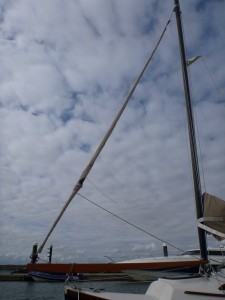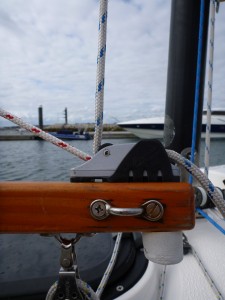A forum member asked what other members’ thought was the best boat modification they had made. For me my jib boom’s topping lift probably falls in to that category because it is so effective and useful and yet also very cheap and simple.
The BayRaider Expedition’s standard jib arrangement is to use a self-tacking jib. This is the same jib as used on the open BayRaider 20 and is a highly effective setup. It needs no attention when tacking and gybing and is thus is perfect when single or short handed. On the BR20 the jib boom drops to the foredeck when the jib is furled. However, on the BRe there is a danger that the jib boom can drop to the side decks, which causes a significant loss of forestay tension and results in an alarming aft rake to the mast. Even if the jib boom doesn’t drop to the side decks it will almost certainly cover the cabin hatch.
The solution is to fit a topping lift.This is simply a line that runs from the jib halyard/forestay to the aft end of the jib boom to support the boom when the jib is furled. As long as the topping lift is attached to the jib halyard somewhere along the line from the jib halyard’s mast block to the jib’s head then the topping lift will work without hindering the jib boom’s swing.
A simple approach is to attach the line to the jib halyard via a bowline and, if the bowline is tied to the right size, i.e. neither too tight nor too lose, this will sit above the knot connecting the jib halyard to the jib furler’s upper swivel. That will be directly above the aft end of the jib boom, which is perfect. An alternative approach would be to attach a Barton high load eye (http://www.bartonmarine.com/products-high-load-eyes.asp – or similar) to the top of the topping lift and route the jib halyard through that.
The other end of the topping lift must be attached to the aft end of the jib boom. This attachment should be adjustable such that topping lift tension can be setup when rigging, adjusted as required and released before re-rigging. A good option is to fit a Clamcleat, e.g. “CL236 – Roller Fairlead Mk1 Racing Junior” (http://www.clamcleat.com/cleats/cleat_details.asp?theid2=57), but the actual attachment method doesn’t matter as long as it works. With the Clamcleat the topping lift comes vertically down to the Clamcleat’s roller and is then routed back through the cleat. Here it can be reached for adjustments from the cockpit when required. Unless you like fine tuning your boat then adjustments should never normally be required when sailing so this arrangement works fine.
The topping lift supports the jib boom when the jib is furled so it doesn’t drop to the side decks or hatch and jib halyard tension remains constant. A further useful benefit is that the jib outhaul no longer affects jib halyard tension, so the jib’s shape can now be adjusted to suit wind strength and your point of sail.
The following photos shows the jib boom being supported by the topping lift and the detail of the top and bottom connections (click on the pictures to see full size versions).



